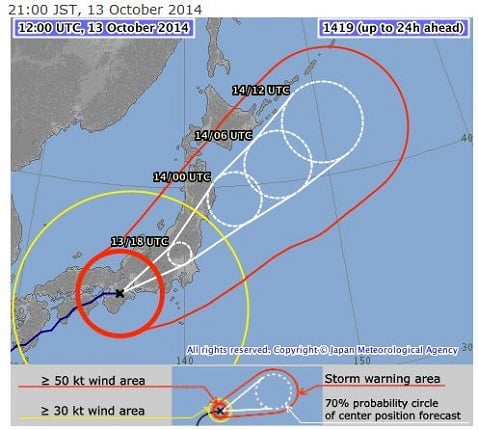Typhoon Vongfong
Status: Closed
| Type of posting | Posting date(EST): | Summary | Downloads |
|---|---|---|---|
| Post Landfall 1 | 10/17/2014 6:15:00 AM |
|
|
| Landfall | 10/13/2014 1:00:00 PM |
|
Landfall | Summary
Posting Date: October 13, 2014, 1:00:00 PM
After inflicting power outages and felling trees in Okinawa over the weekend, Vongfong continued northeast and made landfall on Japan’s Kyushu Island at 9:15 a.m. JST, Monday, October 13 (00:15 UTC). Arriving only days after parts of Japan were affected by Typhoon Phanfone, Vongfong’s soaking rain may potentially cause flash flooding and landslides, even though the storm has weakened considerably as of Monday evening (21:00 JST). Local authorities have issued landslide warnings, and 375,000 people were instructed to evacuate coastal areas of Kyushu Island as Vongfong approached.
Current Conditions
As of Monday night 21:00 JST (12:00 UTC), October 13, 2014, Vongfong—which had achieved super typhoon status last week with wind speeds of more than 257 km/h—has weakened considerably, now exhibiting maximum sustained winds of 115 km/h, with higher gusts of up to 150 km/h. However, Vongfong continues to produce dangerous conditions in southern Japan, and is anticipated to drop hundreds of millimeters of rain, which may result in flash flooding and mudslides, especially in elevated terrain.

Vongfong is forecast to continue northeast and impact much of Japan (Source: JMA)
Reported Damage and Disruption
Over the weekend, Vongfong reportedly felled trees and signs and caused power outages on Okinawa. The storm dropped nearly 500 mm of rain on some portions of the island, including Kunigami district. Making landfall on Japan’s Kyushu Island on Monday morning (JST) as a tropical storm, Vongfong is currently inflicting gusty winds and heavy rains on Kyushu as well as Shikoku Island, where train service and flights have been canceled in response to the storm.
Exposure at Risk
Japan has strict and well-enforced construction codes and, because it regularly experiences extreme precipitation and flooding, it continues to invest heavily in flood defenses. These include the world's largest underground floodwater diversion facility, designed to protect Tokyo from flooding by channeling the overflowing floodwaters from its rivers through tunnels into five huge underground silos.
At the forecast wind speeds from Vongfong, non-engineered structures may experience some roof covering damage. Some poorly constructed wood-frame homes may experience moderate damage, involving loss of the roof covering as well as the removal of porch coverings and awnings. Masonry homes and well-constructed wood-frame homes could have minor damage to roof covering (tiles or shingles), wall siding, soffit panels, and gutters. Some poorly built and not well maintained industrial buildings may lose roofing and siding, especially from windward corners, rakes, and eaves. For engineered structures, structural damage is not expected. Some apartment building and shopping center roof coverings could experience minor levels of damage, and wall sidings may also experience some low levels of damage from these winds.
In preparation for Vongfong’s continued movement northeast across Japan, Tokyo Electric Power Co. (TEPCO) has taken precautions at the Fukushima Daiichi Nuclear Power Station. Specifically, TEPCO has heightened dikes to increase water storage capacity and prevent overflow due to accumulation from rainfall. In addition, TEPCO reports that rainwater may be transferred to different storage tanks, if necessary to prevent overflow.
Possible Impacts
If Vongfong continues to follow its forecast track path, the storm center is anticipated to pass about 200 km to the west of Tokyo on Tuesday, bringing tropical storm force wind gusts and heavy rain to Japan’s capital city. While Vongfong is forecast to continue weakening as it moves east-northeast across Japan, the storm is still expected to inundate the country with heavy rain, especially in mountainous terrain. Flooding and mudslides are a concern, particularly as many areas at risk from Vongfong were affected by Typhoon Phanfone’s strong winds and heavy rains just last week. Tokyo so far has only seen about 50 mm of rainfall from Vongfong.
Typhoons are the most frequent cause of property loss in Japan, and while winds are the predominant driver of loss, the country regularly experiences “wet” storms that deliver extreme precipitation and flooding that contribute substantially to damage.
In Japan, wind damage is typically automatically covered under standard fire insurance policies, but flood damage is not. Property owners who want flood coverage can purchase it as an add-on to a standard policy or they can select a comprehensive policy. Take-up rates for flood are relatively low.
AIR will continue to monitor this storm and provide updates as warranted.